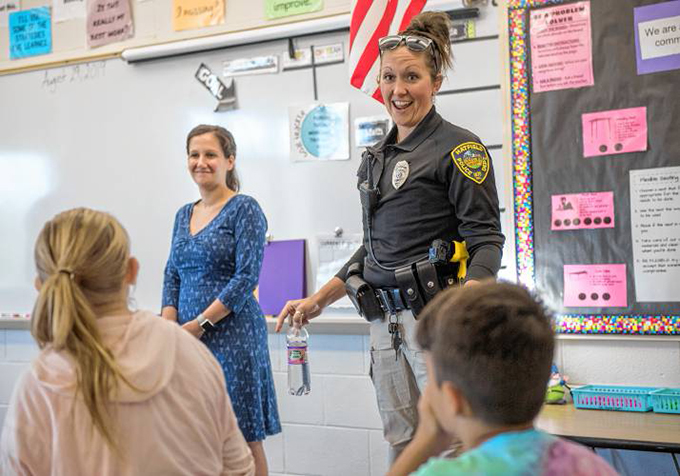
The presence of law enforcement in schools – better known as school resource officers – has become increasingly common. These officers, who have full law enforcement powers, are supposed to keep students safe. Earlier this year, however, a former Michigan school resource officer – Matthew Priebe – was convicted and sentenced to one year in jail for doing just the opposite.
Instead of protecting students from threats, Officer Priebe had been sexually preying on female students, using his power as a school police officer to engage in inappropriate and nonconsensual sexual acts with students.
This latest headline is not a singular event. Within the past year, several other school resource officers have been arrested or convicted of sexual misconduct with students.
The good news is this kind of sexual misconduct appears to be relatively rare.
Still, with police officers now present in about half of schools nationwide, incidents like these raise a number of questions. Just how common are cases of sexual misconduct by school resource officers? And what can be done to prevent incidents in the future?
As an educational researcher who studies school resource officers and school safety, here are my observations regarding these pressing questions.
Prevalence of the problem
According to research by Philip Stinson using the Henry A. Wallace Police Crime Database, there were 32 arrests of school resource officers between 2005 and 2011 for sexual misconduct. Over half (56%) of these incidents occurred with students in the officers’ own schools.
This amounts to fewer than five arrests of school resource officers per year for sexual misconduct out of the more than 30,000 public schools that had police present at least part time during this period.
Of course, research has shown that most acts of sexual misconduct go unreported. Prior research finds that about 10% of students experience sexual misconduct from school personnel at some point in their educational career. This suggests that, while still not the norm, the arrest rate of school resource officers may underestimate the true scope of the problem.
Relationship-building with students
In my own research, my collaborators and I have found that relationship-building with students is an important part of how school resource officers approach their job. In fact, we find that school resource officers prioritize relationship-building with students second only to maintaining security. Similarly, the National Association of School Resource Officers positions counseling/mentoring as one of three key components of school resource officers’ roles.
In our study, school resource officers routinely meet with students one-on-one for informal counseling and give students high-fives and hugs. The officers explain that such activities are aimed at improving students’ views of police and facilitating reporting of threats to security.
We find that students who trust and report comfort talking to school resource officers are more likely than other students to report feeling safe at school. Unfortunately, abuses by school resource officers may undermine this trust and comfort.
Ideas for prevention
School resource officers are hardly the only profession where individuals have been found guilty of sexual misconduct. Teachers, priests, professors, coaches and doctors, among many others, have been exposed in recent years for a number of sexual abuses of youth. Increasingly, more voices have been empowered to bring these abuses to light and hold perpetrators accountable.
How then, might future abuses by school resource officers and others in the education environment be prevented?
Laws and sentences that hold perpetrators accountable with stiffer sentences may be one step in the right direction for deterring future incidents. The one-year sentence for the school resource officer in Michigan is, in my assessment, a light response to a serious abuse of power.
It may also be important for agencies to consider the gender diversity of their school resource officers. All of the school resource officers arrested for sexual misconduct in the Stinson study were male. Fewer than 2 in 10 school resource officers nationally are female. While female school resource officers have also been perpetrators of similar sexual misconduct, a more gender diverse workforce of school resource officers and their leadership may facilitate better oversight and accountability.
Training for school resource officers, teachers and students may also help potentially inappropriate relationships be avoided and those that occur be reported. For example, federal guidance in this area suggests training that helps other adults recognize the signs of abuse, delineates proper boundaries in adult-child relationships and supports the development of policy governing sexual misconduct in schools.
Finally, agencies should look for ways to facilitate safe and easy reporting of incidents that involve sexual misconduct by police. Anonymous tip lines and digital reporting apps may be one way to facilitate greater reporting. Transparency in the record keeping of such incidents would help ensure that patterns of questionable activity are probed and that perpetrators are not protected behind the veils of bureaucracy.
Taking such steps as these could help prevent what occurred in Michigan from repeating elsewhere.
Author Bio: F. Chris Curran is an Associate Professor of Educational Leadership and Policy at the University of Florida
